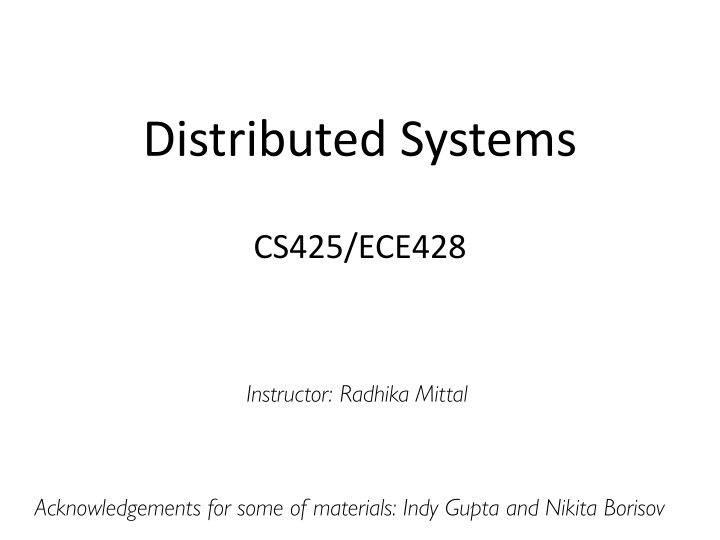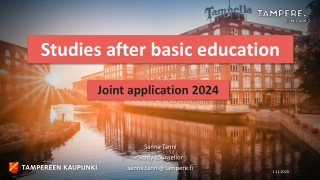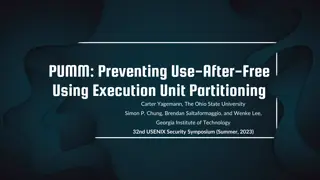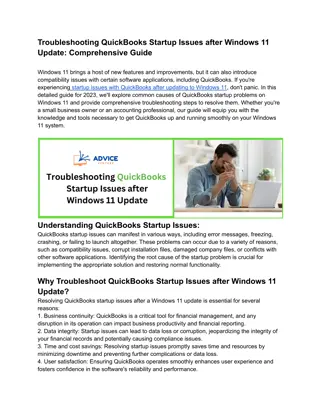
Multicast in Distributed Systems
Dive into the world of multicast in distributed systems with a focus on basic and ordered multicast, including FIFO, causal, and total ordering. Explore the nuances of reliable multicast and implementing total order multicast for effective communication in distributed environments.
Download Presentation

Please find below an Image/Link to download the presentation.
The content on the website is provided AS IS for your information and personal use only. It may not be sold, licensed, or shared on other websites without obtaining consent from the author. If you encounter any issues during the download, it is possible that the publisher has removed the file from their server.
You are allowed to download the files provided on this website for personal or commercial use, subject to the condition that they are used lawfully. All files are the property of their respective owners.
The content on the website is provided AS IS for your information and personal use only. It may not be sold, licensed, or shared on other websites without obtaining consent from the author.
E N D
Presentation Transcript
Distributed Systems CS425/ECE428 Instructor: Radhika Mittal Acknowledgements for some of materials: Indy Gupta and Nikita Borisov
Logistics MP1 has been released. Due on March 4th, 11:59pm. HW1 is due next week Monday. You should be able to solve all questions by now (except 7c). You should be able to solve 7c after the end of today s class. Academic Integrity: Violation: copying from peers, from previous years , from the web, etc.
Todays agenda Wrap up Multicast Chapter 15.4 Tree-based multicast and Gossip Mutual Exclusion Chapter 15.2
Recap: Multicast Useful communication mode in distributed systems: Writing an object across replica servers. Group messaging. .. Basic multicast (B-multicast): unicast send to each process in the group. Does not guarantee consistent message delivery if sender fails. Reliable multicast (R-mulicast): Defined by three properties: integrity, validity, agreement. If some correct process multicasts a message m, then all other correct processes deliver m (exactly once). When a process receives a message m for the first time, it re-multicasts it again to other processes in the group.
Recap: Ordered Multicast FIFO ordering: If a correct process issues multicast(g,m) and then multicast(g,m ), then every correct process that delivers m will have already delivered m. Causal ordering: If multicast(g,m) multicast(g,m ) then any correct process that delivers m will have already delivered m. Note that counts multicast messages delivered to the application, rather than all network messages. Total ordering: If a correct process delivers message m before m , then any other correct process that delivers m will have already delivered m.
Ordered Multicast FIFO ordering: If a correct process issues multicast(g,m) and then multicast(g,m ), then every correct process that delivers m will have already delivered m. Causal ordering: If multicast(g,m) multicast(g,m ) then any correct process that delivers m will have already delivered m. Note that counts multicast messages delivered to the application, rather than all network messages. Total ordering: If a correct process delivers message m before m then any other correct process that delivers m will have already delivered m.
Implementing total order multicast Basic idea: Same sequence number counter across different processes. Instead of different sequence number counter for each process. Two types of approach Using a centralized sequencer A decentralized mechanism (ISIS)
Implementing total order multicast Basic idea: Same sequence number counter across different processes. Instead of different sequence number counter for each process. Two types of approach Using a centralized sequencer A decentralized mechanism (ISIS)
ISIS algorithm for total ordering P2 1 Message 3 P4 2 2 1 3 Agreed Seq 1 2 P1 3 P3
ISIS algorithm for total ordering Sender multicasts message to everyone. Receiving processes: reply with proposed priority (sequence no.) larger than all observed agreed priorities larger than any previously proposed (by self) priority store message in priority queue ordered by priority (proposed or agreed) mark message as undeliverable Sender chooses agreed priority, re-multicasts message id with agreed priority maximum of all proposed priorities Upon receiving agreed (final) priority for a message m Update m s priority to final, and accordingly reorder messages in queue. mark the message m as deliverable. deliver any deliverable messages at front of priority queue. P2 1 Message 3 P4 2 2 1 3 Agreed Seq 1 2 P1 3 P3
Example: ISIS algorithm A A:1 A:2 C:2 B:3 P1 C P2 B:1 A:2 C:3 P3 B:1 A:2 C:3 B
How do we break ties? Problem: priority queue requires unique priorities. Solution: add process # to suggested priority. priority.(id of the process that proposed the priority) i.e., 3.2 == process 2 proposed priority 3 Compare on priority first, use process # to break ties. 2.1 > 1.3 3.2 > 3.1
Example: ISIS algorithm A A:1.1 C:3.3 A:2.3 C:2.1 B:3.1 P1 C P2 B:1.2 B:3.1 A:2.2 A:2.3 C:3.2 C:3.3 P3 B:1.3 B:3.1 A:2.3 C:3.3 B [see .pptx file for animations]
Proof of total order with ISIS Consider two messages, m1 and m2, and two processes, p and p . Suppose that p delivers m1 before m2. When p delivers m1, it is at the head of the queue. m2 is either: Already in p s queue, and deliverable, so finalpriority(m1) < finalpriority(m2) Already in p s queue, and not deliverable, so finalpriority(m1) < proposedpriority(m2) <= finalpriority(m2) Not yet in p s queue: same as above, since proposed priority > priority of any delivered message Suppose p delivers m2 before m1, by the same argument: finalpriority(m2) < finalpriority(m1) Contradiction!
Ordered Multicast FIFO ordering If a correct process issues multicast(g,m) and then multicast(g,m ), then every correct process that delivers m will have already delivered m. Causal ordering If multicast(g,m) multicast(g,m ) then any correct process that delivers m will have already delivered m. Note that counts multicast messages delivered to the application, rather than all network messages. Total ordering If a correct process delivers message m before m , then any other correct process that delivers m will have already delivered m.
More efficient multicast mechanisms Our focus so far has been on the application-level semantics of multicast. What are some of the more efficient underlying mechanisms for a B- multicast?
B-Multicast Sender
B-Multicast using unicast sends Sender TCP/UDP packets
B-Multicast using unicast sends Sender Closer look at physical network paths.
B-Multicast using unicast sends Sender Redundant packets!
B-Multicast using unicast sends Similar redundancy when individual nodes also act as routers (e.g. wireless sensor networks). Sender How do we reduce the overhead?
Tree-based multicast Instead of sending a unicast to all nodes, construct a minimum spanning tree and unicast along that. Sender TCP/UDP packets
Tree-based multicast A process does not directly send messages to all other processes in the group. Sender It sends a message to only a subset of processes. TCP/UDP packets
Tree-based multicast A process does not directly send messages to all other processes in the group. Sender It sends a message to only a subset of processes. Closer look at the physical network.
Tree-based multicast Also possible to construct a tree that includes network routers. IP multicast! Sender
Tree-based multicast What happens if a node fails? Overhead of tree construction and repair. Sender TCP/UDP packets
Third approach: Gossip Transmit to b random targets.
Third approach: Gossip Transmit to b random targets. Other nodes do the same when they receive a message.
Third approach: Gossip Transmit to b random targets. Other nodes do the same when they receive a message.
Third approach: Gossip No tree-construction overhead. More efficient than unicasting to all receivers. Also known as epidemic multicast . Probabilistic in nature no hard guarantees. Good enough for many applications.
Third approach: Gossip Used in many real-world systems: Facebook s distributed datastore uses it to determine group membership and failures. Bitcoin uses it to exchange transaction information between nodes.
Multicast Summary Multicast is an important communication mode in distributed systems. Applications may have different requirements: Basic Reliable Ordered: FIFO, Causal, Total Combinations of the above. Underlying mechanisms to spread the information: Unicast to all receivers. Tree-based multicast, and gossip: sender unicasts messages to only a subset of other processes, and they spread the message further. Gossip is more scalable and more robust to process failures.
Todays agenda Wrap up Multicast Chapter 15.4 Tree-based multicast and Gossip Mutual Exclusion Chapter 15.2 Goal: reason about ways in which different processes in a distributed system can safely manipulate shared resources.
Why Mutual Exclusion? Bank s Servers in the Cloud: Two of your customers make simultaneous deposits of $10,000 into your bank account, each from a separate ATM. Both ATMs read initial amount of $1000 concurrently from the bank s cloud server Both ATMs add $10,000 to this amount (locally at the ATM) Both write the final amount to the server What s wrong?
Why Mutual Exclusion? Bank s Servers in the Cloud: Two of your customers make simultaneous deposits of $10,000 into your bank account, each from a separate ATM. Both ATMs read initial amount of $1000 concurrently from the bank s cloud server Both ATMs add $10,000 to this amount (locally at the ATM) Both write the final amount to the server You lost $10,000! The ATMs need mutually exclusive access to your account entry at the server or, mutually exclusive access to executing the code that modifies the account entry.
More uses of mutual exclusion Distributed file systems Locking of files and directories Accessing objects in a safe and consistent way Ensure at most one server has access to object at any point of time In industry Chubby is Google s locking service
Problem Statement for mutual exclusion Critical Section Problem: Piece of code (at all processes) for which we need to ensure there is at most one process executing it at any point of time. Each process can call three functions enter() to enter the critical section (CS) AccessResource() to run the critical section code exit() to exit the critical section
Our bank example ATM1: enter(); // AccessResource() obtain bank amount; add in deposit; update bank amount; // AccessResource() end exit(); ATM2: enter(); // AccessResource() obtain bank amount; add in deposit; update bank amount; // AccessResource() end exit();
Mutual exclusion for a single OS If all processes are running in one OS on a machine (or VM): Semaphores Mutexes Condition variables Monitors
Processes Sharing an OS: Semaphores Semaphore == an integer that can only be accessed via two special functions Semaphore S=1; // Max number of allowed accessors. wait(S) (or P(S) or down(S)): while(1) { // each execution of the while loop is atomic if (S > 0) { S--; break; } } signal(S) (or V(S) or up(s)): S++; // atomic enter() Atomic operations are supported via hardware instructions such as compare-and-swap, test-and-set, etc. exit()
Our bank example ATM1: enter(); // AccessResource() obtain bank amount; add in deposit; update bank amount; // AccessResource() end exit(); ATM2: enter(); // AccessResource() obtain bank amount; add in deposit; update bank amount; // AccessResource() end exit();
Our bank example Semaphore S=1; // shared ATM1: wait(S); //enter // AccessResource() obtain bank amount; add in deposit; update bank amount; // AccessResource() end signal(S); // exit ATM2: wait(S); //enter // AccessResource() obtain bank amount; add in deposit; update bank amount; // AccessResource() end signal(S); // exit
Mutual exclusion in distributed systems Processes communicating by passing messages. Cannot share variables like semaphores! How do we support mutual exclusion in a distributed system?
Mutual exclusion in distributed systems Our focus today: Classical algorithms for mutual exclusion in distributed systems. Central server algorithm Ring-based algorithm Ricart-Agrawala Algorithm Maekawa Algorithm
Mutual Exclusion Requirements Need to guarantee 3 properties: Safety (essential): At most one process executes in CS (Critical Section) at any time. Liveness (essential): Every request for a CS is granted eventually. Ordering (desirable): Requests are granted in the order they were made.
System Model Each pair of processes is connected by reliable channels (such as TCP). Messages sent on a channel are eventually delivered to recipient, and in FIFO (First In First Out) order. Processes do not fail. Fault-tolerant variants exist in literature.
Mutual exclusion in distributed systems Our focus today: Classical algorithms for mutual exclusion in distributed systems. Central server algorithm Ring-based algorithm Ricart-Agrawala Algorithm Maekawa Algorithm
Central Server Algorithm Elect a central server (or leader) Leader keeps A queue of waiting requests from processes who wish to access the CS A special token which allows its holder to access CS Actions of any process in group: enter() Send a request to leader Wait for token from leader exit() Send back token to leader
Central Server Algorithm Leader Actions: On receiving a request from process Pi if (leader has token) Send token to Pi else Add Pi to queue On receiving a token from process Pi if (queue is not empty) Dequeue head of queue (say Pj), send that process the token else Retain token
Analysis of Central Algorithm Safety at most one process in CS Exactly one token Liveness every request for CS granted eventually With N processes in system, queue has at most N processes If each process exits CS eventually and no failures, liveness guaranteed Ordering: FIFO ordering guaranteed in order of requests received at leader Not in the order in which requests were sent or the order in which processes enter CS!

![Read⚡ebook✔[PDF] Io After Galileo: A New View of Jupiter's Volcanic Moon (Sprin](/thumb/21612/read-ebook-pdf-io-after-galileo-a-new-view-of-jupiter-s-volcanic-moon-sprin.jpg)


![Download Book [PDF] Changing the Game (Offsides Book 1)](/thumb/42244/download-book-pdf-changing-the-game-offsides-book-1.jpg)
![Download Book [PDF] From This Moment: Special Edition Paperback (After We Fall](/thumb/42280/download-book-pdf-from-this-moment-special-edition-paperback-after-we-fall.jpg)
















